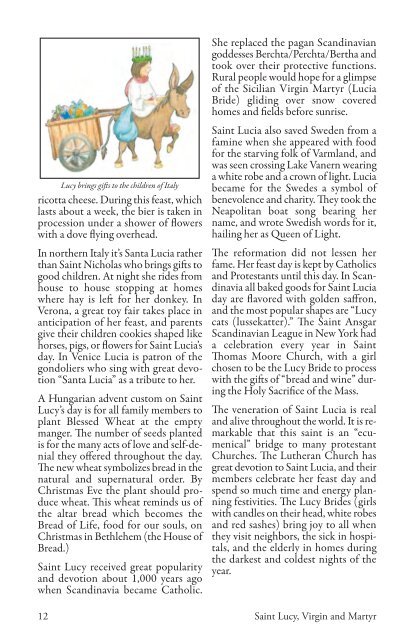Her Death Freed Christianity From the Catacombs - Saint Lucy's ...
Her Death Freed Christianity From the Catacombs - Saint Lucy's ...
Her Death Freed Christianity From the Catacombs - Saint Lucy's ...
You also want an ePaper? Increase the reach of your titles
YUMPU automatically turns print PDFs into web optimized ePapers that Google loves.
Lucy brings gifts to <strong>the</strong> children of Italy<br />
ricotta cheese. During this feast, which<br />
lasts about a week, <strong>the</strong> bier is taken in<br />
procession under a shower of flowers<br />
with a dove flying overhead.<br />
In nor<strong>the</strong>rn Italy it’s Santa Lucia ra<strong>the</strong>r<br />
than <strong>Saint</strong> Nicholas who brings gifts to<br />
good children. At night she rides from<br />
house to house stopping at homes<br />
where hay is left for her donkey. In<br />
Verona, a great toy fair takes place in<br />
anticipation of her feast, and parents<br />
give <strong>the</strong>ir children cookies shaped like<br />
horses, pigs, or flowers for <strong>Saint</strong> Lucia’s<br />
day. In Venice Lucia is patron of <strong>the</strong><br />
gondoliers who sing with great devotion<br />
“Santa Lucia” as a tribute to her.<br />
A Hungarian advent custom on <strong>Saint</strong><br />
Lucy’s day is for all family members to<br />
plant Blessed Wheat at <strong>the</strong> empty<br />
manger. The number of seeds planted<br />
is for <strong>the</strong> many acts of love and self-denial<br />
<strong>the</strong>y offered throughout <strong>the</strong> day.<br />
The new wheat symbolizes bread in <strong>the</strong><br />
natural and supernatural order. By<br />
Christmas Eve <strong>the</strong> plant should produce<br />
wheat. This wheat reminds us of<br />
<strong>the</strong> altar bread which becomes <strong>the</strong><br />
Bread of Life, food for our souls, on<br />
Christmas in Bethlehem (<strong>the</strong> House of<br />
Bread.)<br />
<strong>Saint</strong> Lucy received great popularity<br />
and devotion about 1,000 years ago<br />
when Scandinavia became Catholic.<br />
She replaced <strong>the</strong> pagan Scandinavian<br />
goddesses Berchta/Perchta/Bertha and<br />
took over <strong>the</strong>ir protective functions.<br />
Rural people would hope for a glimpse<br />
of <strong>the</strong> Sicilian Virgin Martyr (Lucia<br />
Bride) gliding over snow covered<br />
homes and fields before sunrise.<br />
<strong>Saint</strong> Lucia also saved Sweden from a<br />
famine when she appeared with food<br />
for <strong>the</strong> starving folk of Varmland, and<br />
was seen crossing Lake Vanern wearing<br />
a white robe and a crown of light. Lucia<br />
became for <strong>the</strong> Swedes a symbol of<br />
benevolence and charity. They took <strong>the</strong><br />
Neapolitan boat song bearing her<br />
name, and wrote Swedish words for it,<br />
hailing her as Queen of Light.<br />
The reformation did not lessen her<br />
fame. <strong>Her</strong> feast day is kept by Catholics<br />
and Protestants until this day. In Scandinavia<br />
all baked goods for <strong>Saint</strong> Lucia<br />
day are flavored with golden saffron,<br />
and <strong>the</strong> most popular shapes are “Lucy<br />
cats (lussekatter).” The <strong>Saint</strong> Ansgar<br />
Scandinavian League in New York had<br />
a celebration every year in <strong>Saint</strong><br />
Thomas Moore Church, with a girl<br />
chosen to be <strong>the</strong> Lucy Bride to process<br />
with <strong>the</strong> gifts of “bread and wine” during<br />
<strong>the</strong> Holy Sacrifice of <strong>the</strong> Mass.<br />
The veneration of <strong>Saint</strong> Lucia is real<br />
and alive throughout <strong>the</strong> world. It is remarkable<br />
that this saint is an “ecumenical”<br />
bridge to many protestant<br />
Churches. The Lu<strong>the</strong>ran Church has<br />
great devotion to <strong>Saint</strong> Lucia, and <strong>the</strong>ir<br />
members celebrate her feast day and<br />
spend so much time and energy planning<br />
festivities. The Lucy Brides (girls<br />
with candles on <strong>the</strong>ir head, white robes<br />
and red sashes) bring joy to all when<br />
<strong>the</strong>y visit neighbors, <strong>the</strong> sick in hospitals,<br />
and <strong>the</strong> elderly in homes during<br />
<strong>the</strong> darkest and coldest nights of <strong>the</strong><br />
year.<br />
12 <strong>Saint</strong> Lucy, Virgin and Martyr


